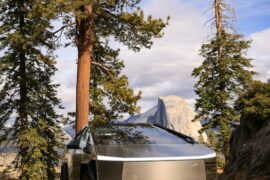In the ever-evolving landscape of electric vehicles (EVs), one company has stood at the forefront of innovation and change—Tesla. Known for pushing the boundaries of what’s possible with electric cars, Tesla has captured the imagination of car enthusiasts and environmentalists alike. However, even the most trailblazing companies can face challenges, and in recent times, a concerning issue has raised its head in the Tesla community: the “Whompy Wheel Problem.”
This article delves into the “What’s Up With Tesla Whompy Wheel Problem?” and why it’s a matter of growing significance, not just for Tesla owners but for anyone invested in the future of the electric car industry. Beyond the sleek designs and cutting-edge technology, safety remains a paramount concern, and the emergence of such issues underscores the importance of addressing vehicle safety concerns in the electric car industry.
Contents
Understanding the “Whompy Wheel Problem”
Define and explain what the “Whompy Wheel Problem” is.
The term “Whompy Wheel Problem” has reverberated throughout Tesla owner circles and automotive forums, leaving many wondering what it entails. At its core, the “Whompy Wheel Problem” refers to a concerning issue related to the structural integrity of Tesla vehicles, specifically their wheels and suspension systems. This problem manifests as abnormal wobbling or vibration, often at highway speeds, which can compromise the vehicle’s stability and safety.

When and where did this issue emerge, and what was its initial impact on Tesla owners?
The “Whompy Wheel Problem” gained notoriety as reports surfaced in various parts of the world, primarily in North America and Europe. Tesla owners who experienced this problem noticed unusual handling characteristics, including erratic steering behavior and vibrations that could be felt through the steering wheel. These unsettling sensations raised significant safety concerns among Tesla owners and enthusiasts, as they questioned the structural integrity of their vehicles.
The initial impact of this problem was twofold: It stirred apprehension among Tesla owners, who had previously held the brand in high regard for its safety and performance, and it drew the attention of automotive experts and regulatory bodies. As more incidents were reported and documented, it became clear that the “Whompy Wheel Problem” was not an isolated occurrence but a potentially widespread issue needing urgent attention.
Tesla’s Response
Detail how Tesla initially responded to reports of the “Whompy Wheel Problem.”
When reports of the “Whompy Wheel Problem” began gaining traction within the Tesla community and the wider automotive world, Tesla swiftly acknowledged the issue as a responsible and customer-focused company. They initiated an internal investigation to determine the root causes and the extent of the problem. Tesla owners who experienced this issue were encouraged to contact the company’s customer support to report their concerns, providing valuable data for Tesla’s engineering teams.
Discuss any measures taken by the company to address the issue.
In response, Tesla implemented several measures to address the “Whompy Wheel Problem.”
1. Enhanced Diagnostics: Tesla developed advanced diagnostic tools to more accurately identify affected vehicles and specific issues related to the wheels and suspension systems.
2. Service Bulletins: The company issued service bulletins to its service centers, guiding how to identify and rectify the issue.
3. Replacement Programs* In cases where the problem was confirmed, Tesla offered affected owners wheel and suspension component replacements as a part of warranty coverage.
4. Software Updates: Tesla deployed over-the-air software updates to address certain aspects of the issue, including stability control and traction control systems.
5. Quality Control Improvements: Tesla is committed to improving the quality control processes in their manufacturing facilities to prevent the issue from arising in new vehicles.
Include statements or communications from Tesla regarding their stance on vehicle safety.

Throughout this process, Tesla consistently communicated its commitment to vehicle safety. The company emphasized its dedication to addressing safety concerns promptly and transparently, aiming to ensure that every Tesla on the road met the highest safety standards. In various official statements, Tesla’s leadership reiterated their intention to work closely with regulators and authorities to resolve the issue, underscoring their unwavering focus on customer safety.
Investigations and Regulatory Involvement
Describe any investigations by relevant authorities or regulatory bodies.
As reports of the “Whompy Wheel Problem” continued to circulate, it drew the attention of various regulatory authorities and agencies responsible for ensuring vehicle safety. These agencies, which often include the National Highway Traffic Safety Administration (NHTSA) in the United States and their counterparts in other countries, launched investigations into the matter. These investigations aimed to assess the validity of the reported issues and determine if they constituted a safety hazard.
Discuss how such investigations may impact Tesla and its reputation.
The initiation of official investigations into the “Whompy Wheel Problem” can significantly impact Tesla and its reputation. Firstly, it underscores the seriousness of the issue, elevating it from a mere concern among Tesla owners to a public and regulatory concern. This increased scrutiny can lead to greater media attention and public awareness of the problem, potentially eroding consumer trust in the brand.
Furthermore, the outcome of these investigations can impact Tesla’s reputation, depending on their findings. If authorities determine that the issue poses a genuine safety risk and that Tesla’s response was insufficient, it could lead to recalls, fines, or mandated corrective actions. On the other hand, if the investigations conclude that the problem is isolated or adequately addressed by Tesla, it may bolster the company’s reputation for transparency and accountability.
Safety Implications
Analyze the potential safety implications of the “Whompy Wheel Problem.”
The “Whompy Wheel Problem” raises significant safety concerns for Tesla owners and the broader electric vehicle industry. The abnormal wobbling or vibrations experienced by affected vehicles can lead to compromised stability and handling, potentially resulting in accidents or loss of control. Such incidents could endanger the vehicle occupants and other road users. It’s imperative to recognize that safety is paramount in the automotive industry, and any issues related to vehicle stability and control demand immediate attention.
Discuss the importance of addressing safety concerns in the electric vehicle industry.
The electric vehicle industry has been rapidly growing, driven by its potential to reduce emissions and revolutionize transportation. However, this industry’s success hinges on public trust; safety is a cornerstone. The emergence of the “Whompy Wheel Problem” underscores the importance of promptly and transparently addressing safety concerns.
For electric vehicles to become a mainstream choice, consumers must have confidence that they are as safe as, or even safer than, traditional internal combustion engine vehicles. Tesla’s response to this issue will influence its reputation and the perception of electric vehicles in general.
Compare this issue to past safety concerns in the automotive industry.
The “Whompy Wheel Problem” is not the first safety concern to affect the automotive industry, and it certainly won’t be the last. Throughout automotive history, there have been safety-related issues, such as faulty airbags, unintended acceleration, and defective ignition switches. These issues led to significant recalls, regulatory scrutiny, and public attention.
Comparing the “Whompy Wheel Problem” to past safety concerns highlights the ongoing need for rigorous quality control, continuous improvement, and accountability in the automotive industry. The ability to swiftly identify and address safety issues is crucial to maintaining public trust and ensuring the long-term success of electric vehicles.
What’s Up With Tesla Whompy Wheel Problem?
The “Whompy Wheel Problem” is a crucial issue for Tesla and the entire electric vehicle industry. It emphasizes the importance of safety in the automotive world and challenges Tesla’s commitment to customer well-being. How Tesla handles this issue will set a precedent for transparency and accountability in the industry.

Safety must be at the forefront as electric vehicles become more prevalent. This problem serves as a reminder that public trust is built on safety. It also reflects the historical pattern of safety issues driving improved standards in the automotive industry.
Banish Unpleasant Tesla AC Smells for a Refreshing Ride in 2023
Incredible Things You Must Know About 20 Induction Wheels 2023
Mastering the Challenge: Steering Assist Reduced Tesla – 2023 Safety Guide





